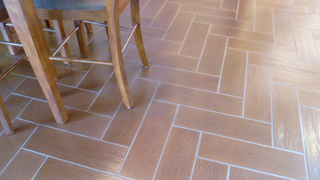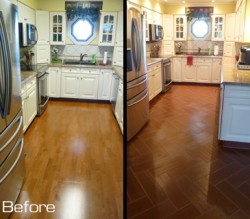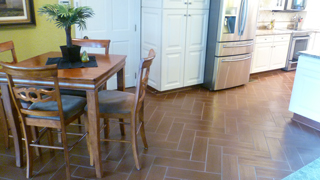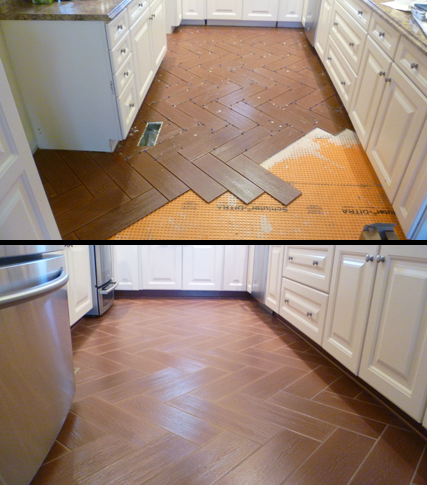 Some tile designs are very distinctive. This project in Ellettsville (Bloomington), Indiana used a Herringbone pattern with tiles that looked like wood planks.
Some tile designs are very distinctive. This project in Ellettsville (Bloomington), Indiana used a Herringbone pattern with tiles that looked like wood planks.
Herringbone is a tile layout that involves alternating tiles diagonally from each other. Being the nerd that I am, I looked it up and yes, the pattern does resemble a herring’s bones! Read more about the origins here. With that out of the way, check out this kitchen! 
 Before the new tile, this kitchen had a laminate floating floor. It was having problems in a few places which I suspect was due to the kitchen cabinets being installed on top of the laminate flooring. This is not a good idea. Laminate flooring is designed to have lateral movement, with expansion gaps around the perimeter. Setting heavy cabinets on it around three sides, as in this kitchen, meant the floor was trapped. As it expanded it ‘bubbled’ up in a few places and didn’t lay flat anymore.
Before the new tile, this kitchen had a laminate floating floor. It was having problems in a few places which I suspect was due to the kitchen cabinets being installed on top of the laminate flooring. This is not a good idea. Laminate flooring is designed to have lateral movement, with expansion gaps around the perimeter. Setting heavy cabinets on it around three sides, as in this kitchen, meant the floor was trapped. As it expanded it ‘bubbled’ up in a few places and didn’t lay flat anymore.
After removing the laminate (see this post) I installed a layer of Ditra underlayment throughout the kitchen and dining area that were to be tiled. Ditra separates or uncouples the tile layer from the subfloor, isolating it from the expansion and contraction that occurs with the wood below. Read lots more about this here.
 Laying tile in a herringbone pattern is a notch or two more complicated than simply laying it diagonally. I made sure I had a straight reference line through the middle of the room using my laser level. (Love that tool!) I marked these pieces with a diagonal line which would line up with my reference line to keep the entire layout running correctly. As with any tile pattern, a little off in one place may add up to a big problem a few feet later. You have to keep things in check.
Laying tile in a herringbone pattern is a notch or two more complicated than simply laying it diagonally. I made sure I had a straight reference line through the middle of the room using my laser level. (Love that tool!) I marked these pieces with a diagonal line which would line up with my reference line to keep the entire layout running correctly. As with any tile pattern, a little off in one place may add up to a big problem a few feet later. You have to keep things in check.










